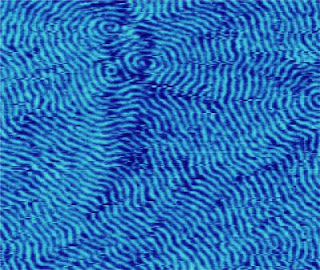Magnets can be classified by their ‘hard’ or ‘soft’ magnetic properties. Hard magnets, sometimes called ‘permanent’ magnets, have fixed or ‘pinned’ domain walls which mean the material stays magnetised for a long time. Soft magnets have moveable domain walls that can be easily flipped. These materials exhibit impermanent magnetic properties.
Professor Gabriel Aeppli, Director of the LCN and a senior member of the research team, explained the significance of the research: “Whether a magnet is hard or soft determines what you can use it for. Typically, you would use a permanent magnet to fix a note to the door of your refrigerator because you want it to stay there for a long time. On the other hand, you might use a soft magnet in a motor or transformer because it would be better at adapting to the rapid changes in alternating current and would dissipate much less energy than a hard magnet.
“It is very rare to be able to continuously tune wall pinning in a magnet but we have now shown how it can be done in a model magnet at a low temperature. In the process, we demonstrate a new route to applications of magnets at higher temperatures and show how chemical disorder at the nanometre (one billionth of a meter) scale can have a huge effect on the properties of a macroscopic (centimetre scale) magnet.”
Most physical and biological systems can be thought of as disordered. Semiconductors rely on randomly placed impurities for their electrical properties and uses, while the chemical and structural impurities in magnets determine the domain wall pinning and therefore how easily their polarity can be changed.
“From a theoretical point of view, it’s been really interesting for us to see the properties of a large, disordered system being dominated to such an extent by a rare configuration of impurities,” says Professor Aeppli. “Unlike biological systems, in materials science we are used to seeing behaviour which is dominated by the average characteristics of the system. Here we can observe the massive influence of a miniscule number of chemical and structural defects.” ###
Contact: Dave Weston d.weston@ucl.ac.uk 44-020-767-97678 University College London
Work at the London Centre for Nanotechnology was funded by the UK Engineering and Physical Sciences Research Council and a Wolfson-Royal Society Research Merit Award. Additional research was also carried out at the University of Chicago.
About the London Centre for Nanotechnology: The London Centre for Nanotechnology is a joint enterprise between University College London and Imperial College London. In bringing together world-class infrastructure and leading nanotechnology research activities, the Centre aims to attain the critical mass to compete with the best facilities abroad.
Furthermore by acting as a bridge between the biomedical, physical, chemical and engineering sciences the Centre will cross the 'chip-to-cell interface' - an essential step if the UK is to remain internationally competitive in biotechnology. Website: london-nano.ucl.ac.uk
About UCL: Founded in 1826, UCL was the first English university established after Oxford and Cambridge, the first to admit students regardless of race, class, religion or gender, and the first to provide systematic teaching of law, architecture and medicine. In the government’s most recent Research Assessment Exercise, 59 UCL departments achieved top ratings of 5* and 5, indicating research quality of international excellence.
UCL is the fourth-ranked UK university in the 2006 league table of the top 500 world universities produced by the Shanghai Jiao Tong University. UCL alumni include Mahatma Gandhi (Laws 1889, Indian political and spiritual leader); Jonathan Dimbleby (Philosophy 1969, writer and television presenter); Junichiro Koizumi (Economics 1969, Prime Minister of Japan); Lord Woolf (Laws 1954, Lord Chief Justice of England & Wales); Alexander Graham Bell (Phonetics 1860s, inventor of the telephone), and members of the band Coldplay.
About the University of Chicago: Founded by oil magnate John D. Rockefeller, the University of Chicago is a private, nondenominational institution of higher learning. Scientists at the University are working at the cutting edge of virtually every field of science, from cosmological astrophysics to molecular genetics and from high-energy particle physics to psychoneuroimmunology. Seventy-nine recipients of the Nobel Prize have been researchers, students or faculty members at the University at some point in their careers. Website: uchicago.edu
Technorati Tags: Nano or Nanotechnology and Nanotech and London Centre for Nanotechnology or electromagnetic devices and magnetic field or Statement of Carl Levin, Chairman of the Senate Armed Services Committee, and Ranking Member John Warner, FULL TEXT and Tiger Woods and Nano-boric acid makes motor oil more slippery















No comments:
Post a Comment